Continued from here
"Leave the flowers to others, still too far away. Your thought remains with the seeds and with the firm grip of the roots …" (Margherita Guidacci, "To myself")
We keep talking about roots. Let’s see their functions and the influences that agricultural practices have on their development.
My main source is “Vine roots” by South African professors E. Archer and D. Saayman (2018, The Institute for Grape and Wine Sciences, Stellenbosch University), as well as several illustrations. This is an excellent overview. The University of Stellenbosch is considered to be the world’s most qualified center on wine-growing soil studies.
Water and water stress
The roots mainly influence the production of the vine on the basis of their ability to ensure water. They have evolved to survive in an environment at the limit for it. So, if well managed, they can be of great help to overcome the difficulties related to the climate change.
The vine does not need a lot of water, indeed it is established that it produces grapes of higher quality when it is a little stressed, not with the maximum of its vigor. However, the stress must not be more than necessary, otherwise the quality of the grapes undergoes and, therefore, of the wine. Especially at certain times of its cycle, the plant must have the water it needs on a regular basis. Conversely, the vine does not like excess water and the roots avoid stagnation areas if possible. They approach the aquifer and absorbs the water that rises above it by capillarity. The water table recedes during the late spring and early summer. The roots, which are in a phase of active growth, follow it (if they do not find obstacles).
Water absorption occurs mainly thanks to the thinnest roots, which is why their optimal development is important. It was once thought that the woody ones (with the bark) were completely excluded from this function. However, they also play a role, especially when the vine awakens and the subtle roots are very few (as we have already seen). The lignified roots can absorb water from the frequent breaks or cracks that form in the bark to allow lateral roots to emerge. However, they have a much lower absorption capacity than non-lignified ones (minus 40-70%).
The absorption and transport of water occurs in the plant mainly thank a sort of “suction” force that is created due to the water loss by leaf transpiration. The water molecules are strongly cohesive with each other and pressed in the thin tubes of the xylem (this is why we speak of capillarity): they thus form a kind of train, made up of many wagons linked together, which are dragged upwards.
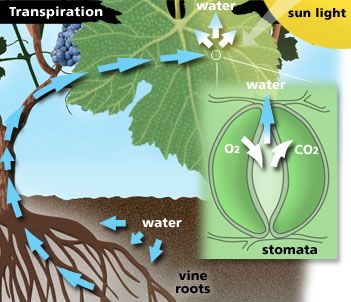
In the early spring, however, the leaves are not there yet. In this phase, the water thrust comes from the roots. When the soil begins to warm up, the roots resume metabolic activity and an osmotic potential is created, that causes water absorbation. That generates a pressure in the roots that pushes the water upwards. The roots are capable of very strong pressure: it has been calculated that they could carry water up to a height of 35 meters. When there’ll be enough transpiring leaves, they’ll become predominant in leading the process.

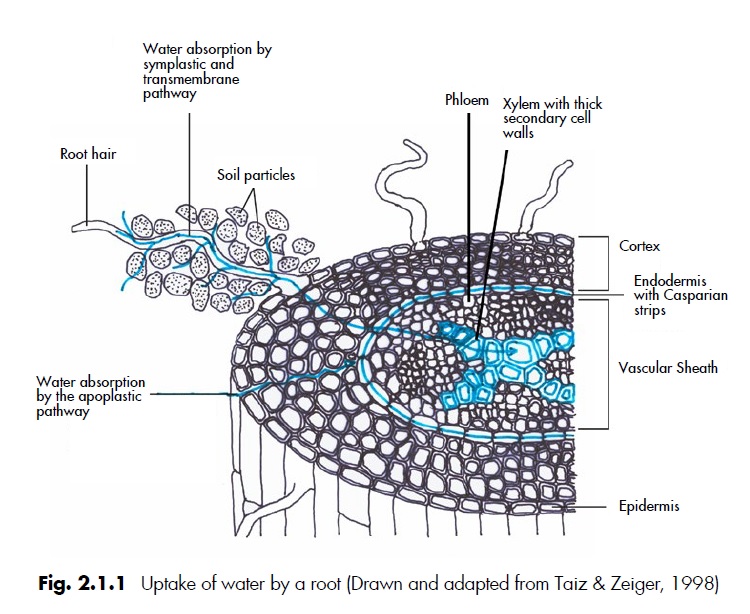
How does the plant regulate the flow of water? The vine, following a water stress, brings into play a whole series of changes that are driven by hormones, mostly produced by the roots, which we will see later. Among the different responses, there is the limitation of transpiration with the closure of the stomata, the stimulation of the root growth, the inhibition of the growth of the shoots, the production of proteins that prevent the cell membranes from drying out, etc.
In general, the grapevine has a great ability to resist drought, more than many other plants. It depends on its ability to form, if necessary, very long roots that are able to explore the soil and reach the water. This ability is essential in Mediterranean climates where summer is arid but, if the soil characteristics allows it, the roots can reach the deepest or most distant humid areas.
In a drought climate, however, there are other problems for plants. If part of the roots cannot find water, it may dry out and die. Also, imagine a straw where you suck too hard: the walls could crush, blocking any other transport. The great ability of the vine to resist water stresses also depends on its particular resistance to the contraction of the xylem vessels. However, this also happens because the vine is not a simple suction straw. Water does not enter only by physical forces, but, as mentioned, the plants control and regulate the flow. Moreover, compared to other plants, the vine has a not so thin xylem system. For this reason, the grapevine has a low hydraulic resistance: the “suction” is never too strong (except in really extreme conditions). For the same reason, the roots that remain without water do not die: there is a quickly redistribution to them of the available water. This phenomenon is called hydraulic conductivity of the roots.
However, in very extreme conditions, even the vines can have problem. If the aspiration become too intense, some air bubbles may form in the vessels (embolism) which interrupt the water column and hinder the transport.
Mineral salts
In addition to water, the roots also absorb mineral salts. They are essential for the nutrition of the vine, to support all its vital functions. Some, such as phosphorus and nitrogen, are indispensable for stimulating the growth and branching of the roots.
The grapevine has the reputation of being able to live in very poor soils, due to its ability to use the minimum presence of minerals and to “go and look for them”. The roots, in fact, have a strong chemotropism: they develop in the direction of where they find the nutrients. For this reason, it is important that there is not too intense fertilization, especially in the first years of the vineyard, otherwise the roots would be induced to develop only in the fertilized areas.
The roots of the vine also have the ability to avoid, up to a certain point, intoxication due to excesses of some substances, such as sodium or metals (as aluminum or copper). Their transport is blocked in the roots and they are stored.
The absorption of mineral elements occurs mainly in the thinnest roots. Some, such as potassium, can migrate centimeters, nitrogen even over 10 cm. Some elements instead (such as boron, phosphorus and calcium) must be in the immediate vicinity of the root to be absorbed, a few millimeters away. In these cases, the help of the subtle hyphae of the mycorrhizae can be useful.
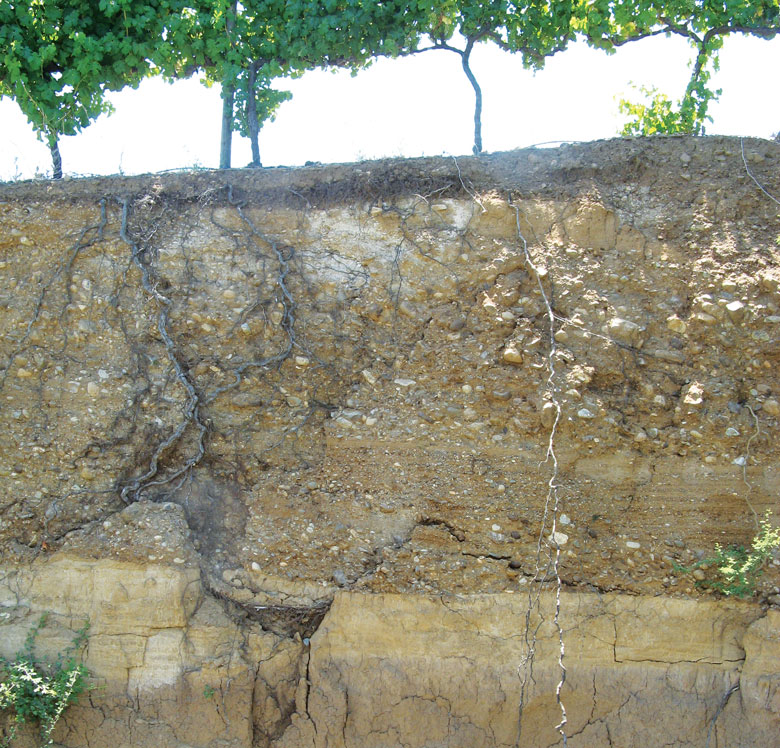
The absorption of the mineral elements of the soil, as well as for water, can take place both passively and actively. Mineral salts are absorbed in the form of cations and anions. As for water, the passage into the endodermis is only active, after neutralizing the charges. The ions are bound to transport molecules, which accompany them in the passage through cell membranes and then in the xylem flow.
The absorption of mineral salts is not continuous. Understanding their cycles is essential to understand the moments of real need for the vine. For example, one of the most important elements is nitrogen, the absorption of which has peaks and periods of stasis throughout the year. From awakening to the end of the rapid growth phase of the shoots, the plant seems to depend above all on the nitrogen accumulated the previous year. The vine begins to accumulate nitrogen again after the flowering until the veraison. From the veraison to the harvest, the absorption stops and the bunches are replenished above all by that accumulated up to that moment. After the harvest, the root absorption begins again: that is an important moment to restore stocks, in view of the future budding. The roots continue to accumulate nitrogen until the leaves fall.
For iron uptake, one of the most difficult times for the plant is that of the pre-flowering phase, , when it can show symptoms of deficiency. This happens because the iron is mainly absorbed by the tips of the thinnest roots which, at this stage, may still not be sufficient in the cooler climates.
However, there is a huge difference between the different rootstocks in the ability to absorb the different mineral elements from the soil solution, making them more or less sensitive to certain deficiency problems.
Storage of reserves
The vine not only accumulates nitrogen but also other reserves to support particularly difficult phases of its life. The stocks are made up of mineral salts, sugars and other substances (amino acids, citric acid, etc.). The sugars are produced by the photosynthesis and are stored in a storable form, the starch. When it is needed, some enzymes are activated that break down the starch into sugars (especially sucrose, as well as glucose and fructose). All the woody parts of the plant can act as storage sites for the reserves, but 80% of the starch and 70% of the nitrogen are in the roots, the rest in the trunk. Potassium, for example, is higher in the trunk.
The spring awakening of the vine is totally dependent on these reserves. It cannot be otherwise: at this stage, the leaves (that produce sugars with photosynthesis) are not yet there and the thinnest roots, the most absorbent ones, have not yet developed. The reserves remain important throughout the growth phase of the shoots. Then, they are partially restored, and consumed to support the growth of the bunches. Finally, they are strongly restored after the harvest, to guarantee the possibility for the plant to start a new cycle the following spring.
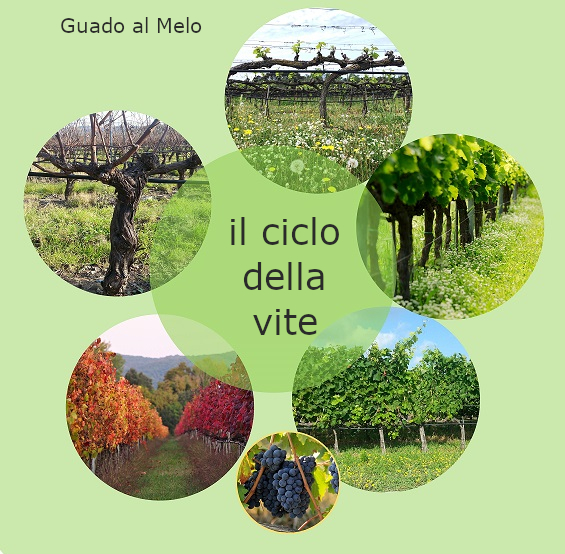
After the harvest, you might think that the vine will go into dormancy and therefore don’t need much. On the contrary, it is working hard to accumulate stocks. Therefore, it is essential that the vine has the correct availability of nutrients, particularly nitrogen and potassium, and that it can continue to do photosynthesis as long as it can. Several studies have shown that vines that have accumulated low reserves in the fall will produce a limited number of shoots at the time of budding and will have poor shoot growth. The autumn accumulation can be altered by environmental stresses such as excessive drought, excess water, soil depletion, … This is why it is said that one vintage affect its production but also (partly) the next. Bad cultivation practices can also have a negative effect, such as too early pruning (done before the natural fall of the leaves), poor soil management, lack of fertilization, etc.
The production of hormones
Another very important function of the roots is the production of most of the hormones, chemical messengers that modulate the reaction of the vine to its environment. Let us therefore remember that any negative condition that prevents the growth and function of the roots, interferes with the synthesis of hormones, thus modifying the general performance of the plant.
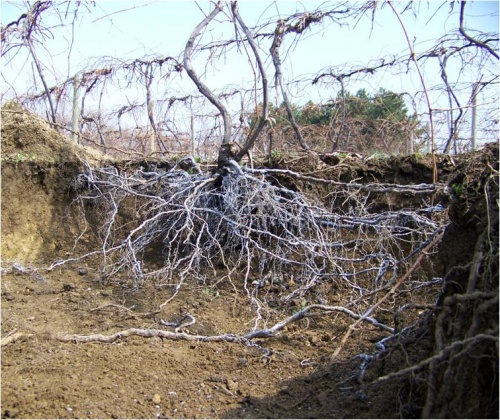
The main plant hormones are a group of molecules that are divided into 5 families: auxins, gibberellic acids or gibberellins, cytokinins, abscisic acids (ABA) and ethylene. The first three are mainly related to plant growth stimuli, the last two mainly to the aging and ripening of the fruit. ABA is among the most important for the response to water stress, with the regulation of the closure of the stomata. These hormones never act alone, but always in relation to one another. All the processes of growth, development and maturation of the vine are the result of the variable ratios of these hormones. That creates the possibility of a very fine and differentiated regulation.
The production of hormones depends on the stimuli of the external environment, both natural and those caused by the winemakers (pruning or topping, for example). The least expected aspect is that the most important stimuli do not come so much from the surface environment but often from that of the soil, that is, those that act on the roots: water stagnation, dryness, salinity, nutritional deficiencies, damage to roots due to toxicity phenomena for various substances, parasites, root cutting, etc.
It is not a hormone, but the roots of the vines are also the main area of production and accumulation of the citric acid. It is transported from here to the fruits, where it is oxidized to malic acid.
The influence of the agricultural practices
I have already talked about different practices in the course of the description of the roots, but here I add others that have a strong influence on the development of the roots.
A central moment, but often overlooked, is that of the birth of the vineyard. Numerous studies have shown that mistakes made in this phase, in relation to the root system, compromise the entire future life of the vineyard, both in the quality of production and in its longevity. The planting of the vineyard is fundamental: you have only one chance to do it well, afterwards it is impossible to change. First of all, of course, there is the choice of where to make the vineyard, in relation to what has been explained so far on the importance of the soil characteristics. Therefore, it is essential to know your soil well with well-done geological analyzes, in order to understand its viticultural potential, guide the choices of planting and of the future management. Another essential step is the preparation of the soil. This preparatory work affects the actual depth of the soil. It has been seen that an absent or shallow preparation in any case limits the root growth to the most superficial layers and there can never be sufficient root colonization.
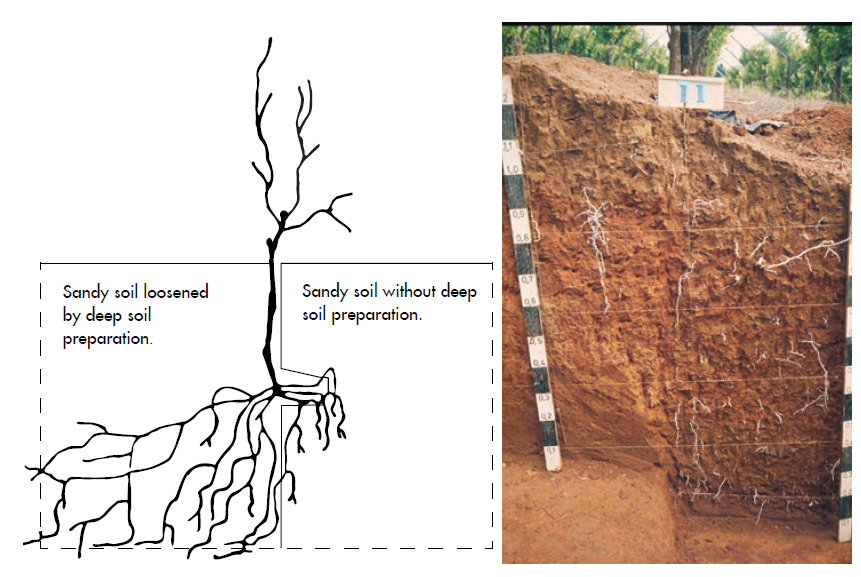
Numerous studies have also shown that the way in which vines are planted also affects the root growth and its distribution throughout the life of the vineyard. If the digging system compacts the earth too much on the sides and bottom, it create like a small cage from which the roots will no longer be able to get out. The root reduction is also reflected in a weak growth of the rest of the plant. The depth of the excavation is also relevant: if shallow, the vine often dies from drying out; if too deep, downward root growth is inhibited. It is also better to make attention to too small holes, excessive cuts of the roots, to the distribution of roots in the digging hole, etc.
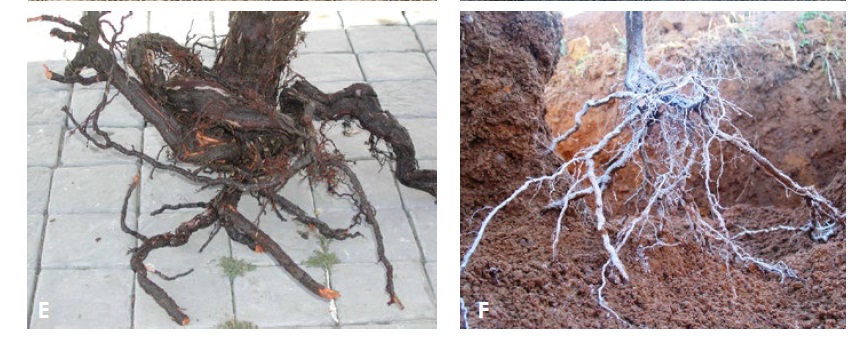
It has been seen that there is a decrease in the root mass for each vine with the increase in planting density (as we can expect). However, it has been seen that there is also an increase in the density of the roots, especially in the deeper profiles of the soil, with a better use of the available volume. However, by increasing the density too much, this positive effect stops, with a reduction in vigor that affect the quality of the grapes. Furthermore, with too high planting density, the soil resources can be consumed too quickly before the end of the growing season, especially in a dry and poor soil. Therefore, the choice of plant density should be determined by the potential of the soil to induce vegetative growth. Let us remember that it is a slight stress that gives better grapes. Too much stress produces poor grapes (and wine).
Once the plantation is done, it is important to keep the soil at its best to have optimal roots. Over time, the soil tends to compact and impoverish. For example, it has been seen that the frequent passage of the tractors in the vineyard can create a hard layer that reaches even 60 cm in depth.
The choice of the soil cultivation (how often, how deep and where) is linked to each specific situation. However, it has a destructive action on the roots of the worked layer. The utility of the root pruning is discussed. If done badly, too deep or too frequent, it has an inevitable limiting effect on the plant growth. If done lightly, it causes a slight stress on the vine which can increase grape quality. A light stress also seems to push the roots to colonize hitherto unexplored parts of the soil. In general, compared to the past, today most of winemakers avoid deep and continuous cultivation, which in any case affect too much the root system.
The roots that are most affected by the work of the winemaker are the superficial ones, also known as interception roots, which usually lie between 7,5 and 25 cm of soil. Numerous studies have shown how different soil management affects them in different ways. The most superficial roots remain in a soil managed with herbicides or mulch, while they are absent whit soil cultivation or with grassing (for a competitive effect). They can decrease in any case with the bare soil, because it is more subject to temperature fluctuations and excessive dryness. However, the different managements of the soil have consequences on the roots that can become advantages or disadvantages depending on the specific soil and climatic situation. If we do not know specifically our soil characteristics, we cannot choose the best management for our vineyards. For example, the grassing limits the vine’s roots in the most superficial layers of the soil, but it can positively stimulate the exploration of the deeper ones. However, this is only an advantage if the soil is really deep, and if the layers are suitable for the roots.
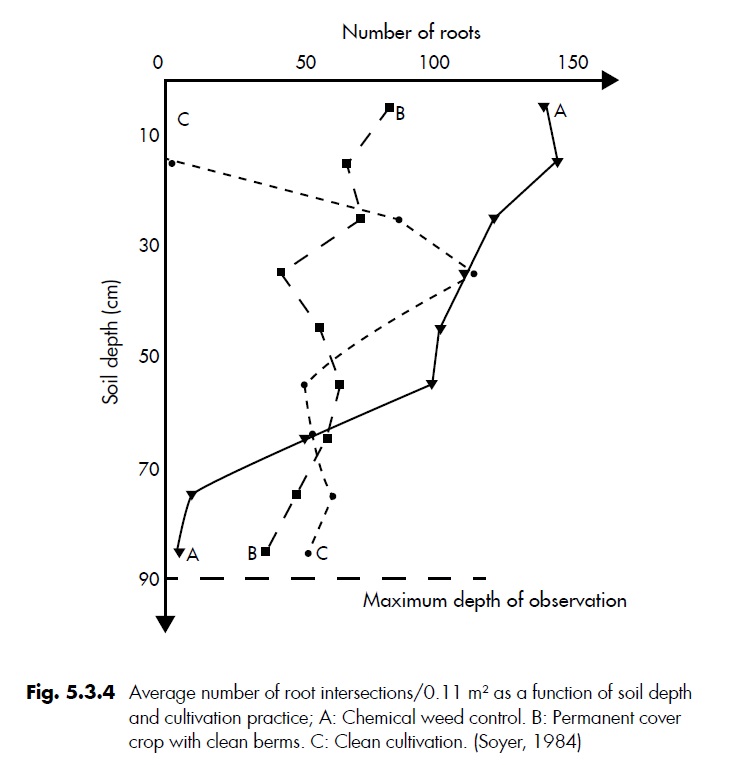
Also fertilization has an important effect on the root system. It has been found that the best effect on root growth comes from composting with vegetable waste, such as shredded shoots from pruning. These also create a layer of mulch which makes the soil temperature more stable and avoids excessive surface dryness, as well as a natural herbicide effect. Instead, the constant use of manure has been demonstrated to depress root growth. It appears to have an excessive salinizing effect on the soil and, in the long run, also causes nitrate poisoning. However, it has the faster effect on the growth of the shoots, significantly increasing their vigor. Furthermore, it should be remembered that the vine does not feed on organic material but on inorganic salts. Sufficient mineralization for vine’s demands is not so obvious. So, the inorganic fertilization should not be neglected when necessary.
The research on irrigation is much more present in the countries of the new world than in the old. Since the roots are strongly guided by water in their growth, it has been seen that the implementation and management of the irrigation system has a very strong effect on their development. For example, irrigation plants that are focused and superficial, such as the drip one, tend to limit the development of roots enormously, especially if used in the first years of the vineyards. In this case, the roots concentrate in the small part of the soil where they find water and become dependent on irrigation forever, even when it would be not needed. The irrigation plants, if needed, should be realized in such a way as to favor optimal root development.
Also the other works in the vineyard have an effect on the roots, even if the studies are not numerous. For example, studies on the relationship between pruning and the root system have given quite conflicting results. It seems that the growth of the root system is more stimulated with medium pruning. Negative effects were found with too severe pruning or, vice versa, with too much buds. The defoliation seems to have benefits on root growth and the development of thin roots in particular. However, it must be well calibrated for the climatic situation. If done too early or too intensely, the density of the roots decreases.
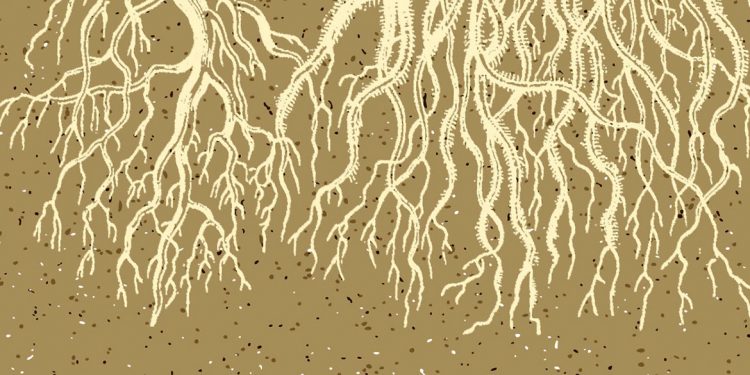
I hope you have understood the centrality of the roots and therefore of how their care should be privileged, starting from the creation of the vineyard. The vine is able to withstand environmental stresses, as well as producing high quality wines, only if it manages to develop an optimal root system. So, it is important to know all the aspects that influence the development and growth of roots in our vineyards: soil, climate, the influence of each agricultural practice, …
Winemakers who love their vineyards don’t stop at the surface.